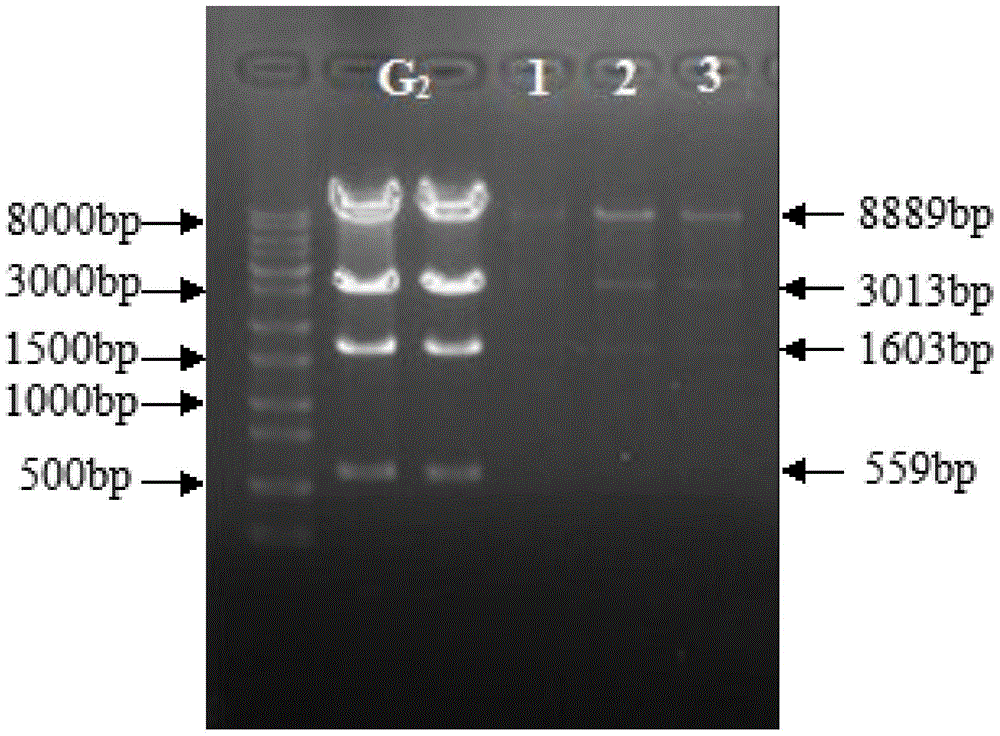Agrobacterium tumefaciens-mediated camelina sativa genetic transformation method
A genetic transformation method and the technology of Agrobacterium tumefaciens are applied in the field of genetic transformation of flax mustard mediated by Agrobacterium tumefaciens, which can solve the problems of undiscovered patent publications and the like, and achieve the advantages of being suitable for popularization and application, simple equipment, and improved transformation. The effect of efficiency
- Summary
- Abstract
- Description
- Claims
- Application Information
AI Technical Summary
Problems solved by technology
Method used
Image
Examples
Embodiment 1
[0055] A method for genetic transformation of flax mustard mediated by Agrobacterium tumefaciens, through the construction and identification of engineering strains carrying target genes, cultivation of flax mustard seedlings, control of transformation timing, and preparation of vacuum infiltration devices, so that the engineering strains can be impregnated with flax mustard , co-cultivation, resistance screening, PCR detection, and finally obtain the transgenic plants of linseed mustard.
[0056] The method for genetic transformation of flax mustard mediated by Agrobacterium tumefaciens is carried out as follows:
[0057] (1) Construction and identification of engineering strains: using CaCl 2 Agrobacterium tumefaciens competent cells were prepared by this method, and 100 μL / tube was aliquoted, and used directly for transformation within 24 hours or quickly frozen in liquid nitrogen and stored at -80°C for later use. The carrier plasmid (the carrier plasmid is pBG1100 with k...
Embodiment 2
[0076] A method for the genetic transformation of flax mustard mediated by Agrobacterium tumefaciens, through the construction and identification of engineering strains carrying the target gene, cultivation of flax mustard seedlings, control of transformation timing, preparation of vacuum infiltration device, and then infecting the engineering strains The specific steps of flax mustard, co-cultivation, resistance screening, PCR detection, and finally obtaining the transgenic plants of flax mustard are as follows:
[0077] 1. Construction and identification of engineering strains
[0078] (1) Using CaCl 2 Prepare competent cells of Agrobacterium tumefaciens by using the method, aliquot 100 μL / tube, and use them directly for transformation within 24 hours or freeze them in liquid nitrogen and store them at -80°C for later use;
[0079] (2) Introduce the vector plasmid pBinGlyBar1 into Agrobacterium tumefaciens competent cells by the heat shock method, add 800 μL of YEB medium, ...
Embodiment 3
[0091] A method for the genetic transformation of flax mustard mediated by Agrobacterium tumefaciens, through the construction and identification of an engineering strain carrying a target gene, the specific steps are as follows:
[0092] (1) Using CaCl 2 Prepare competent cells of Agrobacterium tumefaciens by using the method, aliquot 100 μL / tube, and use them directly for transformation within 24 hours or freeze them in liquid nitrogen and store them at -80°C for later use;
[0093] (2) Use the heat shock method to transform the vector plasmid pBinGlyBar1 into Agrobacterium tumefaciens, add 800 μL of YEB medium, mix well and place it in a 28°C environment for 2 hours; centrifuge at 4500r / min for 45s at room temperature, remove most of the supernatant 700μL , take 100 μL of the remaining supernatant to resuspend the bacteria, spread the resuspended bacteria on a YEB solid resistance plate containing 50 mg / L rifampicin and 50 mg / L kanamycin, and culture it upside down at 28°C ...
PUM
 Login to View More
Login to View More Abstract
Description
Claims
Application Information
 Login to View More
Login to View More - R&D
- Intellectual Property
- Life Sciences
- Materials
- Tech Scout
- Unparalleled Data Quality
- Higher Quality Content
- 60% Fewer Hallucinations
Browse by: Latest US Patents, China's latest patents, Technical Efficacy Thesaurus, Application Domain, Technology Topic, Popular Technical Reports.
© 2025 PatSnap. All rights reserved.Legal|Privacy policy|Modern Slavery Act Transparency Statement|Sitemap|About US| Contact US: help@patsnap.com



